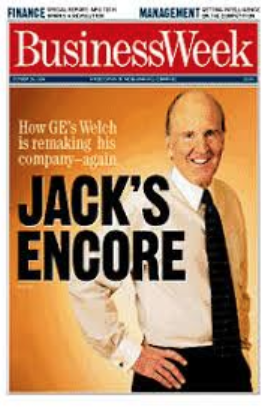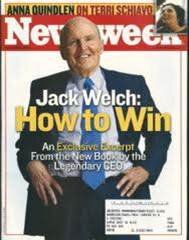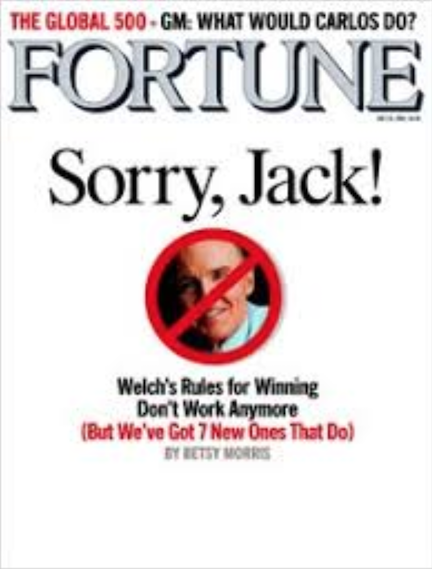The Legacy of Neutron Jack
Jack Welch died recently.
And as usual with such public figures, the media fell over themselves to praise him to the skies.
Welch, who was named "Manager of the Century" by Fortune magazine in 1999, massively increased the might of GE during his time as CEO. The market value of GE stock rose from $14 billion to approx. $400 billion, an increase of more than 2,700%, during those 20 years.
Welch pushed his people to get aggressive, not to give up. His goal of “be No 1 or No 2 in your market” was partly a way to raise expectations, to get people to believe they should succeed, and take risks. His “speed, simplicity, and self-confidence” program fought bureaucracy. And his “rank or yank” program dismissed 10% of the workforce each year, to combat complacency.
The famed “GE University” at Crotonville trained his executives in his philosophy, and many of them went on to improve operations throughout the American economy.
Jack Welch was my hero when I entered the workforce in the early 90s. There were so many books and articles on him and I must have read almost all of them.
Tradition also dictates that we do not speak ill of the dead. De Mortuis Nil Nisi Bonum etc. etc.
But, I detest fakes.
It’s almost always the case that a leader’s true legacy is felt long after he has left office. And Welch’s actual track record and legacy at GE has proved rather more “complicated” (to put it very mildly), as I have been finding out.
The dumbest idea in the world
Jack Welch in his tenure as CEO of GE from 1981 to 2001 was seen as the uber-hero of maximizing shareholder value.
The initial champion was the economist Milton Friedman. Friedman had declared that “there is one and only one social responsibility of business—to use its resources and engage in activities designed to increase its profits.” Finance professors William Meckling and Michael Jensen offered a quantitative economic rationale for maximizing shareholder value, along with generous stock-based compensation to executives who followed the theory. They explained how the personal interests of executives could be aligned with those of the corporation and its shareholders. Now managers would act like owners. In the 1980s, Ronald Reagan and Margaret Thatcher gave the idea political cover: business should get back to basics. Government was the problem, not the solution.
But alas a mighty gap opened up between theory and practice.
CEOs became very entrepreneurial — but often in their own cause, not necessarily the organization’s cause. The use of the phrase “maximize shareholder value” exploded. Compensation practices changed. Stock-based compensation became the norm for the C-suite. Shareholder value became the gospel of American capitalism.
The sophisticated form of “long-term discounted cash flows” is unimplementable for day-to-day decision-making. And the bastardized form is the current stock price, The Economist writes that shareholder value thinking has become “a license for bad conduct, including skimping on investment, exorbitant pay, high leverage, silly takeovers, accounting shenanigans and a craze for share buy-backs, which are running at $600 billion a year in America.” Two distinguished Harvard Business School professors–Joseph L. Bower and Lynn S. Paine—recently declared in Harvard Business Review that maximizing shareholder value is “the error at the heart of corporate leadership.” It is “flawed in its assumptions, confused as a matter of law, and damaging in practice”.
The pursuit of short-term shareholder value has also led to firms allocating almost all the gains that flowed from workers’ improvements in productivity to just one group- shareholders, including executives. This is one big reason for the growing inequality in the US today with the resultant demotivated and disengaged workforce.
Shareholder value theory has not only failed on its own narrow terms of making money for shareholders. It has been steadily destroying the productive capacity and dynamism of the entire economy.
The worst place to work
For decades, GE practiced (and preached) a rigid system championed by Welch of ranking employees. Known as the Vitality Curve (aka forced ranking, forced distribution, rank and yank, quota-based differentiation, and stack ranking), the system was based on the annual performance review, and boiled the employees’ performance down to a number on which they were judged and ranked against peers. A bottom percentage (10% in GE’s case) of underperformers were then fired.
This became a fad in corporate America. As organizational behavior expert David A. Thomas put it then, "companies are playing their version of 'Survivor'”.
Welch’s style was confrontation, in “brutal candor,” in argument, and in pushing people extremely hard. He ran the company by sheer force of will and personality. His success at GE came at a high price, as his draconian approach made GE a fearful place to work. Even apart from the massive layoffs, people were often under intense stress. The workout consultants became a parallel organization, almost a secret police force. All of this had a demoralizing effect.
There WAS a good reason for this style. GE was a bloated industrial conglomerate that was facing extraordinary competition from Asian manufacturers in industrial businesses that were becoming increasingly commoditized. That brutal reality led to obsessions with cost, efficiency, and operational excellence, which were embodied in Neutron Jack’s management style.
In any case, this approach has been discredited. There’s a growing realization these days that the annual review isn’t a good way to manage people or to boost performance. Plus, it can lead to HR focusing too much on process over outcomes.
Smoothening earnings
Over the last 30 years GE has been accused many times of manipulating or managing its earnings to smooth out results, timing when certain gains or losses might be reported. Throughout Welch's time as CEO GE reported nothing but steady earnings growth that met or beat forecasts, even when external economic factors created much more uneven results at its competitors.
GE Capital helped Welch do that. As the Wall Street Journal wrote, GE Cap was “… a handy, deep bucket of financial spackle with which to smooth over the cracks in quarterly earnings reports and keep Wall Street happy. Sometimes that meant peddling half a parking lot on the final day of a quarter, or selling a part interest in a power plant only to purchase it back after the quarter closed”
Then there were the proven cases of dodgy hedge accounting, fake locomotive sales and fake spare part sales that occurred from 2001 to 2005. While these happened well after Welch had left, GE was simply continuing something Welch started.
The SEC eventually accused GE in 2009 of manipulating results. GE settled those charges, paying a $50 million fine. But in one of those quirks inherent in the American legal system, it did not admit wrongdoing. "GE bent the accounting rules beyond the breaking point," said Robert Khuzami, then Director of the SEC's Division of Enforcement.
Even today, GE's accounting remains controversial.
More crucially, Welch’s success led other CEOs to begin using financial wizardry to improve earnings and wow Wall Street.
Deliberately confusing numbers
GE has also long been criticized for using cloudy accounting and confusing reporting metrics that made it incredibly difficult for investors to determine the company's true performance and situation.
The Wall Street Journal published a series highlighting how GE’s "murky" accounting makes it hard to understand its cash flow.
Take GE's "industrial CFOA," which is supposed to measure free cash flow. But a footnote explains this measure excludes deal taxes as well as pension plan funding, a huge cost at GE!
Welch the bomb maker
Despite his industrial background, Jack ended up relying more on financial services and entertainment than with manufacturing. The firm’s numbers just looked better with these non-industrial divisions.
He expanded GE Capital, a mere lending arm for customers, to the point where it contributed a massive 40% of GE’s profits. Over time, the emphasis on financial services drained capital from the industrial businesses. It was effectively a too-big-to-fail bank, inside a company that makes power plants and MRI machines.
GE Capital became a ticking time bomb, a huge liability during the financial crisis. It got so bad in October 2008 that GE couldn't borrow money when the overnight lending market vanished, forcing it to get an emergency investment from Warren Buffett and other investors.
GE should have sold GE Capital long before it got so big that it endangered the rest of the company.
Boosting profit by under providing for liabilities
GE’s earnings in the last five years of Welch’s tenure rose from 72 cents a share to $1.37, a 90% (!) increase.
The trouble with this near doubling was that it was due almost entirely to socking away too little money to protect GE Capital’s reinsurance unit (“ERC”), to cover future insurance claims.
After Neutron Jack left, Immelt had to boost ERC reserves by $61 billion, or 61 cents a share — effectively wiping out all but 4 cents per share of the earnings gains seen in the last five years of Welch’s tenure. Hence, if GE had not left ERC pathetically under-reserved, GE’s earnings would have grown by a mere 4 cents per share, or 5.6 percent, in the last five years of Welch’s run.
A mediocre performance, not the stuff of legends.
A big trailing mess
In early 2018, as he conducted a painful review of the whole business, John Flannery, who took over from Immelt as CEO, liked to point out there are no sacred cows.
He announced that trailing liabilities from the residue of GE Capital, the group’s financial operation, would cost it $15bn more than expected over the next seven years.
GE Capital must set aside $15 billion to cover the costs of health insurance companies' policies that it re-insures. Those policies proved more expensive than GE expected. The setback is rooted in North American Life & Health (‘NAL”) , a part of the company’s GE Capital division that helps cover the risks assumed by insurers that sell policies to consumers. NAL stopped writing new policies in 2006, but before that it reinsured about 300,000 policies covering the long-term health care of people in the final years of their lives.
NAL underestimated how much it would cost to pay for the care of people who lived longer than projected, a mistake that was magnified when the low interest rates of the past decade slashed the investment returns on the policy premiums
Another legacy of the “manager of the century”.
Good Luck Welch
Welch’s success may not have been all his doing, either. Jack be nimble, Jack be quick, but man was Jack a lucky dog!
Welch took over as CEO in late 1981. This was as a 16-year bear market was coming to an end, and on the eve of a historic 18-year bull market. He left a week before the September 11 attacks, and before GE Capital and other new divisions started losing value.
We cannot underestimate how significant that good fortune was in the Welch-is-a-genius narrative. Investors consistently confuse correlation with causation.
He was in the right place at the right time.
If we give him credit for his smart moves in the 1980s, exiting some industries and expanding into others, then he should get some blame for staying in vulnerable areas in the late 1990s.
Like many executives, he lost his edge near the end of his tenure and left a mess to his successor.
Obsession with unrelated businesses
GE is still a clutch of unconnected businesses ranging from aircraft engines to energy to appliances to health care to financial services.
Immelt may have been slow in backing away from GE.’s strategy of operating a slew of unrelated businesses (so long as each was top performer in its category) — but it was Welch who pursued that strategy so aggressively in the first place.
This conglomerate approach has become “dated”. It is still used in a few old-line manufacturing businesses, but not in the rest of the economy, where a start-up can destroy your business.
The Master of PR
By the time he retired, a shipload of books claiming to reveal Welch’s leadership ways and wisdom clogged the business sections of booksellers, and finance pundits called him “the CEO of the century,”.
In the years after, he wrote his own (mega-selling) books about his “business philosophy”, opined in the finance media, and founded the Jack Welch Management Institute with its MBA course (God knows what toxic management twaddle was being taught in that course!).
One big plus Welch had: At the time, GE owned NBC, including the financial and business news channel CNBC. Welch of course carefully managed his image via the channel, invariably getting good press. The anchors even joked about softball questions while interviewing the boss.
This craven reaction not only set the tone for the rest of the press, but it helped create and drive the myth of Welch, making him almost bulletproof in the investing public’s imagination.
Incredibly unrepentant
He left a bloated, hollow mess to his successors. GE went from being a titan of industry to a dismembered wreck.
But if Welch ever felt any responsibility for the problems Immelt faced — or doubts about whether his hero status was fully deserved — he didn’t go out of his way to show it.
In fact, he was reported to have turned on Immelt in private, supposedly even telling others that choosing Immelt was “one of the biggest mistakes” of his career, as one report put it. But Immelt inherited a company from Welch that had brushed a lot of issues under the rug.
Summary
Was Welch a management legend? A PR genius? A very lucky CEO? A cheat who cooked the books for decades? The man responsible for popularizing the disastrous concept of shareholder capitalism? A ruthless corporate tyrant? An unrepentant, emotionally dyslexic leader? Incredibly shit at picking a successor?
I have watched him and GE for nearly 25 years, and I think he was all of these. The mind boggles at the sheer scale and pervasiveness of his toxic legacy, not just within GE or within the US but in the corporate world globally.
It’s time we understood the man as a seriously flawed maverick, and swiftly took him down from the pedestal.








